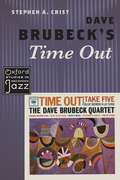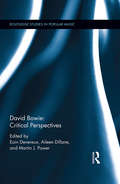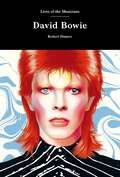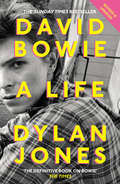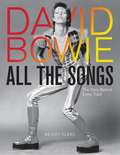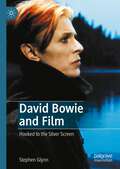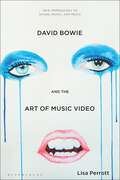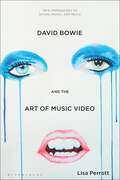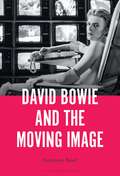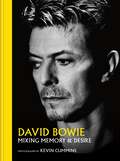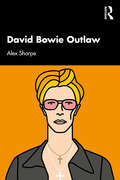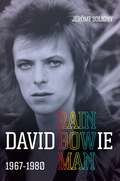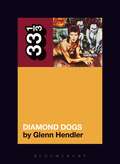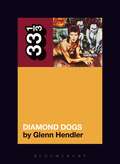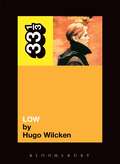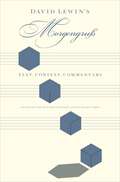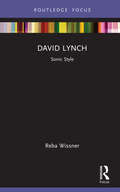- Table View
- List View
Dave Brubeck's Time Out (Oxford Studies in Recorded Jazz)
by Stephen A. CristDave Brubeck's Time Out ranks among the most popular, successful, and influential jazz albums of all time. Released by Columbia in 1959, alongside such other landmark albums as Miles Davis's Kind of Blue and Charles Mingus's Mingus Ah Um, Time Out became one of the first jazz albums to be certified platinum, while its featured track, "Take Five," became the best-selling jazz single of the twentieth century, surpassing one million copies. In addition to its commercial successes, the album is widely recognized as a pioneering endeavor into the use of odd meters in jazz. With its opening track "Blue Rondo à la Turk" written in 9/8, its hit single "Take Five" in 5/4, and equally innovative uses of the more common 3/4 and 4/4 meters on other tracks, Time Out has played an important role in the development of modern jazz. In this book, author Stephen A. Crist draws on nearly fifteen years of archival research to offer the most thorough examination to date of this seminal jazz album. Supplementing his research with interviews with key individuals, including Brubeck's widow Iola and daughter Catherine, as well as interviews conducted with Brubeck himself prior to his passing in 2012, Crist paints a complete picture of the album's origins, creation, and legacy. Couching careful analysis of each of the album's seven tracks within historical and cultural contexts, he offers fascinating insights into the composition and development of some of the album's best-known tunes. From Brubeck's 1958 State Department-sponsored tour, during which he first encountered the Turkish aksak rhythms that would form the basis of "Blue Rondo à la Turk," to the backstage jam session that planted the seeds for "Take Five," Crist sheds an exciting new light on one of the most significant albums in jazz history.
DAVE BRUBECK'S TIME OUT OSRJ C (Oxford Studies in Recorded Jazz)
by Stephen A. CristDave Brubeck's Time Out ranks among the most popular, successful, and influential jazz albums of all time. Released by Columbia in 1959, alongside such other landmark albums as Miles Davis's Kind of Blue and Charles Mingus's Mingus Ah Um, Time Out became one of the first jazz albums to be certified platinum, while its featured track, "Take Five," became the best-selling jazz single of the twentieth century, surpassing one million copies. In addition to its commercial successes, the album is widely recognized as a pioneering endeavor into the use of odd meters in jazz. With its opening track "Blue Rondo à la Turk" written in 9/8, its hit single "Take Five" in 5/4, and equally innovative uses of the more common 3/4 and 4/4 meters on other tracks, Time Out has played an important role in the development of modern jazz. In this book, author Stephen A. Crist draws on nearly fifteen years of archival research to offer the most thorough examination to date of this seminal jazz album. Supplementing his research with interviews with key individuals, including Brubeck's widow Iola and daughter Catherine, as well as interviews conducted with Brubeck himself prior to his passing in 2012, Crist paints a complete picture of the album's origins, creation, and legacy. Couching careful analysis of each of the album's seven tracks within historical and cultural contexts, he offers fascinating insights into the composition and development of some of the album's best-known tunes. From Brubeck's 1958 State Department-sponsored tour, during which he first encountered the Turkish aksak rhythms that would form the basis of "Blue Rondo à la Turk," to the backstage jam session that planted the seeds for "Take Five," Crist sheds an exciting new light on one of the most significant albums in jazz history.
David Bowie: Critical Perspectives (Routledge Studies in Popular Music)
by Eoin Devereux Aileen Dillane Martin PowerDavid Bowie: Critical Perspectives examines in detail the many layers of one of the most intriguing and influential icons in popular culture. This interdisciplinary book brings together established and emerging scholars from a wide variety of backgrounds, including musicology, sociology, art history, literary theory, philosophy, politics, film studies and media studies. Bowie’s complexity as a singer, songwriter, producer, performer, actor and artist demands that any critical engagement with his overall work must be interdisciplinary and wide-ranging in its scope. The chapters are organised around the key themes of ‘textualities’, ‘psychologies’, ‘orientalisms’, ‘art and agency’ and ‘performing and influencing’ in Bowie’s work. This comprehensive book contributes a great deal to the study of popular music, performance, gender, religion, popular media and celebrity.
David Bowie (Lives of the Musicians)
by Robert DimeryA relentless innovator, scoring chart hits while simultaneously incorporating radical and ground-breaking elements into his work.As with all great pop stars, Bowie's image changed with almost every new album release. This appetite for reinvention, both musically and visually, saw him dubbed the 'chameleon of pop'. But Bowie's influence extended well beyond his discography and make-up drawer. His androgynous qualities and public statements on his sexuality proved liberating for those who were uncertain about their own. Lives of the Musicians: David Bowie covers the years he spent struggling to find the right artistic outlet to the dramatic breakthrough in 1972 with Ziggy Stardust - and afterwards, the excessive lifestyle that nearly cost him his sanity. It continues with his artistic rebirth in Berlin during the late Seventies, the mainstream success he achieved with Let's Dance in 1983 and the artistic price that he paid for it.
David Bowie: Critical Perspectives (Routledge Studies in Popular Music)
by Eoin Devereux, Aileen Dillane, and Martin J. PowerDavid Bowie: Critical Perspectives examines in detail the many layers of one of the most intriguing and influential icons in popular culture. This interdisciplinary book brings together established and emerging scholars from a wide variety of backgrounds, including musicology, sociology, art history, literary theory, philosophy, politics, film studies and media studies. Bowie’s complexity as a singer, songwriter, producer, performer, actor and artist demands that any critical engagement with his overall work must be interdisciplinary and wide-ranging in its scope. The chapters are organised around the key themes of ‘textualities’, ‘psychologies’, ‘orientalisms’, ‘art and agency’ and ‘performing and influencing’ in Bowie’s work. This comprehensive book contributes a great deal to the study of popular music, performance, gender, religion, popular media and celebrity.
David Bowie: A Life
by Dylan Jones** Shortlisted for the NME Best Music Book Award 2018 **THE SUNDAY TIMES BESTSELLERA TIMES BOOK OF THE YEARA GUARDIAN BOOK OF THE YEARA HERALD BOOK OF THE YEARAN IRISH INDEPENDENT BOOK OF THE YEAR'The definitive book on Bowie' The Times Drawn from a series of conversations between David Bowie and Dylan Jones across three decades, together with over 180 interviews with friends, rivals, lovers, and collaborators - some of whom have never before spoken about their relationship with Bowie - this oral history is an intimate portrait of a remarkable rise to stardom and one of the most fascinating lives of our time.Profoundly shaped by his relationship with his schizophrenic half-brother Terry, Bowie was a man of intense relationships that often came to abrupt ends. He was a social creature, equally comfortable partying with John Lennon and dining with Frank Sinatra, and in Dylan Jones's telling - by turns insightful and salacious - we see as intimate a portrait as could possibly be drawn.Including illuminating, never-before-seen material from Bowie himself, drawn from a series of Jones’s interviews with him across three decades, DAVID BOWIE is an epic, unforgettable cocktail-party conversation about a man whose enigmatic shapeshifting and irrepressible creativity produced one of the most sprawling, fascinating lives of our time.***NOW REVISED AND EXPANDED***
David Bowie All the Songs: The Story Behind Every Track (All the Songs)
by Benoît ClercAlbum by album and track by track, this first-of-its-kind catalog of David Bowie's entire 50-year and 27-album career tells the story of one of rock's all-time greatest artists.A lovingly thorough dissection of every album and every track ever released by David Bowie over the span of his nearly 50 year career, David Bowie All the Songs follows the musician from his self-titled debut album released in 1967 all the way through Blackstar, his final album.Delving deep into Bowie's past and featuring new commentary and archival interviews with a wide range of models, actors, musicians, producers, and recording executives who all worked with and knew the so-called "Thin White Duke", David Bowie All the Songs charts the musician's course from a young upstart in 1960s London to a musical behemoth who collaborated with everyone from Queen Latifah and Bing Crosby, to Mick Jagger and Arcade Fire.This one-of-a-kind book draws upon years of research in order to recount how each song was written, composed, and recorded, down to the instruments used and the people who played them. Featuring hundreds of vivid photographs that celebrate one of music's most visually arresting performers, David Bowie All the Songs is a must-have book for any true fan of classic rock.
David Bowie and Film: Hooked to the Silver Screen
by Stephen GlynnThis book constitutes the first monograph dedicated to an academic analysis of David Bowie’s appearances in film. Through close textual analysis together with production and reception histories, Bowie’s ‘silver screen’ career is explored in full. The book covers performance documentaries such as Ziggy Stardust and the Spiders from Mars, star vehicles ranging from the eulogised The Man Who Fell to Earth to the excoriated Just a Gigolo, plus roles from the horror chic of The Hunger and cult fantasy of Labyrinth to the valiant high-brow Baal and vainglorious high-budget Absolute Beginners, ending with Bowie as Bowie in Bandslam and others as ‘Bowie’ in Velvet Goldmine and Stardust. Alongside showing his willingness to experiment (and at times fail) across a variety of genres, this study investigates Bowie’s performative style that, while struggling to accommodate the requirements of cinematic realism, fits more harmoniously with alternative production codes and aesthetics. More broadly, by exploring the commercial, socio-cultural and ideological significance of Bowie on film, the book demonstrates how notions of gender, sexuality and identity formation, plus commodity and cultural capital, function and fluctuate in contemporary society.
David Bowie and Romanticism (Palgrave Studies in Music and Literature)
by James RoviraDavid Bowie and Romanticism evaluates Bowie’s music, film, drama, and personae alongside eighteenth- and nineteenth-century poets, novelists, and artists. These chapters expand our understanding of both the literature studied as well as Bowie’s music, exploring the boundaries of reason and imagination, and of identity, gender, and genre. This collection uses the conceptual apparata and historical insights provided by the study of Romanticism to provide insight into identity formation, drawing from Romantic theories of self to understand Bowie’s oeuvre and periods of his career. The chapters discuss key themes in Bowie’s work and analyze what Bowie has to teach us about Romantic art and literature as well.
David Bowie and the Art of Music Video (New Approaches to Sound, Music, and Media)
by Dr. Lisa PerrottThe first in-depth study of David Bowie's music videos across a sustained period takes on interweaving storyworlds of an iconic career. Remarkable for their capacity to conjure elaborate imagery, Bowie's videos provide fascinating exemplars of the artistry and remediation of music video. When their construction is examined across several years, they appear as time-travelling vessels, transporting kooky characters and strange story-world components across time and space. By charting Bowie's creative and collaborative process across five distinct phases, David Bowie and the Art of Music Video shows how he played a vital role in establishing music video as an artform. Filling a gap in the existing literature, this book shines a light on the significant contributions of directors such as Mick Rock, Stanley Dorfman and David Mallet, each of whom taught Bowie much about how to use the form. By examining Bowie's collaborative process, his use of surrealist strategies and his integration of avant-garde art with popular music and media, the book provides a history of music video in relation to the broader fields of audiovisual media, visual music and art.
David Bowie and the Art of Music Video (New Approaches to Sound, Music, and Media)
by Dr. Lisa PerrottThe first in-depth study of David Bowie's music videos across a sustained period takes on interweaving storyworlds of an iconic career. Remarkable for their capacity to conjure elaborate imagery, Bowie's videos provide fascinating exemplars of the artistry and remediation of music video. When their construction is examined across several years, they appear as time-travelling vessels, transporting kooky characters and strange story-world components across time and space. By charting Bowie's creative and collaborative process across five distinct phases, David Bowie and the Art of Music Video shows how he played a vital role in establishing music video as an artform. Filling a gap in the existing literature, this book shines a light on the significant contributions of directors such as Mick Rock, Stanley Dorfman and David Mallet, each of whom taught Bowie much about how to use the form. By examining Bowie's collaborative process, his use of surrealist strategies and his integration of avant-garde art with popular music and media, the book provides a history of music video in relation to the broader fields of audiovisual media, visual music and art.
David Bowie and the Moving Image
by Katherine ReedThe central image of David Bowie's “Life on Mars?” could have been ripped from his own experience: a child sits “hooked to the silver screen,” reliving fantastical scenes played out on film. Throughout his life, Bowie was similarly transfixed by the power of film. From his first film role in The Image to his final music video before his death, “Lazarus,” Bowie's musical output has long been intrinsically linked to images. Analyzing Bowie's music videos, planned film projects, acting roles, and depictions in film, David Bowie and the Moving Image provides a comprehensive view of Bowie's work with film and informs our understanding of all areas of his work, from music to fashion to visual art. It enters the debate about Bowie's artistic legacy by addressing Bowie as musician, actor, and auteur.
David Bowie and the Moving Image
by Katherine ReedThe central image of David Bowie's “Life on Mars?” could have been ripped from his own experience: a child sits “hooked to the silver screen,” reliving fantastical scenes played out on film. Throughout his life, Bowie was similarly transfixed by the power of film. From his first film role in The Image to his final music video before his death, “Lazarus,” Bowie's musical output has long been intrinsically linked to images. Analyzing Bowie's music videos, planned film projects, acting roles, and depictions in film, David Bowie and the Moving Image provides a comprehensive view of Bowie's work with film and informs our understanding of all areas of his work, from music to fashion to visual art. It enters the debate about Bowie's artistic legacy by addressing Bowie as musician, actor, and auteur.
David Bowie Mixing Memory & Desire: Photographs by Kevin Cummins
by Kevin Cummins"AS ICONIC PHOTOGRAPHER, ADVENTUROUS FAN AND INSIDEREYE-WITNESS, KEVIN CUMMINS HAS ALWAYS BEEN WHERE THE CULTURALACTION IS. MIXING MEMORY & DESIRE WILL MAKE YOU SEE DAVID BOWIE INA SURPRISING AND STIMULATING NEW WAY." -PAUL MORLEY"DAVID BOWIE WAS ON A CREATIVE JOURNEY THROUGH MUSIC,FASHION AND ART. A JOURNEY UNPARALLELED IN POPULAR CULTURE.WHAT A PRIVILEGE IT IS FOR US THAT KEVIN CUMMINS WAS THERE TOCAPTURE THIS JOURNEY. HIS WONDERFUL BOOK SHOWS US EXACTLYWHY BOWIE WAS SO UNIQUE." -NOEL GALLAGHER"KEVIN BRILLIANTLY CAPTURES THE ESSENCE OF THE GREAT MAN INTHESE REMARKABLE PHOTOGRAPHS. CUMMINS IS SO ADEPT AT BREAKINGDOWN THE BARRIER OF THE CAMERA, YOU SENSE BOWIE IS COMPLETELYAT EASE WHEN THEY WORKED TOGETHER" -GOLDIEThe career of celebrated photographer Kevin Cummins began on 29th June 1973 when, as a nineteen-year-old photography student, he photographed David Bowie. That image is now in the renowned photography collection of the V&A Museum and marked the beginning of Kevin Cummins' four-decade-long visual chronicle of David Bowie's remarkable career. David Bowie: Mixing Memory & Desire includes some of the best portraits of Bowie ever taken, the majority of which have never been published until now. From those legendary Bowie gigs in the early 1970s, through to a poignant image taken outside his apartment in New York in 2016, Cummins has captured the many faces of Bowie and created a book that is essential for Bowie fans everywhere.
David Bowie Outlaw: Essays on Difference, Authenticity, Ethics, Art & Love
by Alex SharpeThis book explores the relevance of David Bowie’s life and music for contemporary legal and cultural theory. Focusing on the artist and artworks of David Bowie, this book brings to life, in essay form, particular theoretical ideas, creative methodologies and ethical debates that have contemporary relevance within the fields of law, social theory, ethics and art. What unites the essays presented here is that they all point to a beyond law: to the fact that law is not enough, or to be more precise, too much, too much to bear. For those who, like Bowie, see art, creativity and love as what ought to be the central organising principles of life, law will not do. In the face of its certainties, its rigidities, and its conceits, these essays, through Bowie, call forth the monster who laughs at the law, celebrate inauthenticity as a deeper truth, explore the ethical limits of art, cut up the laws of writing and embrace that which is most antithetical to law, love. This original engagement with the limits of law will appeal to those working in legal theory, ethics and law and popular culture, as well as in art and cultural studies.
David Bowie Outlaw: Essays on Difference, Authenticity, Ethics, Art & Love
by Alex SharpeThis book explores the relevance of David Bowie’s life and music for contemporary legal and cultural theory. Focusing on the artist and artworks of David Bowie, this book brings to life, in essay form, particular theoretical ideas, creative methodologies and ethical debates that have contemporary relevance within the fields of law, social theory, ethics and art. What unites the essays presented here is that they all point to a beyond law: to the fact that law is not enough, or to be more precise, too much, too much to bear. For those who, like Bowie, see art, creativity and love as what ought to be the central organising principles of life, law will not do. In the face of its certainties, its rigidities, and its conceits, these essays, through Bowie, call forth the monster who laughs at the law, celebrate inauthenticity as a deeper truth, explore the ethical limits of art, cut up the laws of writing and embrace that which is most antithetical to law, love. This original engagement with the limits of law will appeal to those working in legal theory, ethics and law and popular culture, as well as in art and cultural studies.
David Bowie Rainbowman: 1967-1980
by Jérôme Soligny'This is a book unlike any other, the definitive analysis of David's music, told in a quiet natural way, but with absolute authenticity, by the people around him.' - HERMIONE FARTHINGALE'Jérôme Soligny is one of the best authorities in the world on David Bowie's career and life in general... His new biography Rainbowman is a thorough and honest account of the great man.' - TONY VISCONTI'Jérôme is a guy who is still aware that popular music is an art form and not a money suppository. He writes from the heart and is one of the last exemplars of a dying breed. The critic, armed with intelligence and brute compulsive honesty, as dangerous as a river.' - IGGY POP'Not long ago, Jérôme told me something that I find very true: "David played saxophone, guitar, a bit of keyboards, but above all, he played musicians!" I think he really hit the nail on the head.' - MIKE GARSONIn David Bowie Rainbowman, Jérôme Soligny tells the story of David Bowie the musician with the help of those intimately involved with the creation of his music.This uniquely exhaustive work on Bowie's 1967-1980 albums draws on over 150 interviews with the musicians, producers and friends who knew Bowie best, including Robert Fripp, Hermione Farthingale, Lou Reed, George Underwood, Mick Ronson, Carlos Alomar, Trevor Bolder, Mike Garson, Woody Woodmansey and many, many others. With an essay by Soligny on each album followed by oral histories from the most trusted and influential figures in Bowie's musical life, David Bowie Rainbowman is the definitive guide to a singular and mercurial genius - the Rainbowman himself.· With a foreword by Tony Visconti, an introduction by Mike Garson and cover photo by Mick Rock· A beautiful and stylish gift for Bowie fans, over 700 pages long, filled with iconic photographs and with striking cover design by Barnbrook
David Bowie's Diamond Dogs (33 1/3 #143)
by Glenn HendlerAfter his breakthrough with Ziggy Stardust and before his U.S. pop hits "Fame" and "Golden Years" David Bowie produced a dark and difficult concept album set in a post-apocalytic "Hunger City" populated by post-human "mutants." Diamond Dogs includes the great glam anthem "Rebel Rebel" and utterly unique songs that combine lush romantic piano and nearly operatic singing with scratching, grungy guitars, creepy, insidious noises, and dark, pessimistic lyrics that reflect the album's origins in a projected Broadway musical version of Orwell's 1984 and Bowie's formative encounter with William S. Burroughs. In this book Glenn Hendler shows that each song on Diamond Dogs shifts the ground under you as you listen, not just by changing in musical style, but by being sung by a different "I" who directly addresses a different "you." Diamond Dogs is the product of a performer at the peak of his powers but uncomfortable with the rock star role he had constructed. All of the album's influences looked to Bowie like ways of escaping not just the Ziggy role, but also the constraints of race, gender, sexuality, and nationality. These are just some of the reasons many Bowie fans rate Diamond Dogs his richest and most important album of the 1970s.
David Bowie's Diamond Dogs (33 1/3 #143)
by Glenn HendlerAfter his breakthrough with Ziggy Stardust and before his U.S. pop hits "Fame" and "Golden Years" David Bowie produced a dark and difficult concept album set in a post-apocalytic "Hunger City" populated by post-human "mutants." Diamond Dogs includes the great glam anthem "Rebel Rebel" and utterly unique songs that combine lush romantic piano and nearly operatic singing with scratching, grungy guitars, creepy, insidious noises, and dark, pessimistic lyrics that reflect the album's origins in a projected Broadway musical version of Orwell's 1984 and Bowie's formative encounter with William S. Burroughs. In this book Glenn Hendler shows that each song on Diamond Dogs shifts the ground under you as you listen, not just by changing in musical style, but by being sung by a different "I" who directly addresses a different "you." Diamond Dogs is the product of a performer at the peak of his powers but uncomfortable with the rock star role he had constructed. All of the album's influences looked to Bowie like ways of escaping not just the Ziggy role, but also the constraints of race, gender, sexuality, and nationality. These are just some of the reasons many Bowie fans rate Diamond Dogs his richest and most important album of the 1970s.
David Bowie's Low (33 1/3)
by Hugo WilckenLos Angeles, 1976. David Bowie is holed up in his Bel-Air mansion, drifting into drug-induced paranoia and confusion. Obsessed with black magic and the Holy Grail, he's built an altar in the living room and keeps his fingernail clippings in the fridge. There are occasional trips out to visit his friend Iggy Pop in a mental institution. His latest album is the cocaine-fuelled Station To Station (Bowie: "I know it was recorded in LA because I read it was"), which welds R&B rhythms to lyrics that mix the occult with a yearning for Europe, after three mad years in the New World.Bowie has long been haunted by the angst-ridden, emotional work of the Die Brucke movement and the Expressionists. Berlin is their spiritual home, and after a chaotic world tour, Bowie adopts this city as his new sanctuary. Immediately he sets to work on Low, his own expressionist mood-piece.
David Bowie's Low (33 1/3)
by Hugo WilckenLos Angeles, 1976. David Bowie is holed up in his Bel-Air mansion, drifting into drug-induced paranoia and confusion. Obsessed with black magic and the Holy Grail, he's built an altar in the living room and keeps his fingernail clippings in the fridge. There are occasional trips out to visit his friend Iggy Pop in a mental institution. His latest album is the cocaine-fuelled Station To Station (Bowie: "I know it was recorded in LA because I read it was"), which welds R&B rhythms to lyrics that mix the occult with a yearning for Europe, after three mad years in the New World.Bowie has long been haunted by the angst-ridden, emotional work of the Die Brucke movement and the Expressionists. Berlin is their spiritual home, and after a chaotic world tour, Bowie adopts this city as his new sanctuary. Immediately he sets to work on Low, his own expressionist mood-piece.
David Lewin's Morgengruß: Text, Context, Commentary
by David Bard-Schwarz Richard CohnArguably one of the most influential and revered figures in contemporary music theory, David Lewin (1933-2003) revolutionized the field through his work on transformational theory and theoretical methodology. David Lewin's Morgengruß: Text, Context, Commentary presents in print for the first time Lewin's legendary 1974 essay on Franz Schubert's "Morgengruß," from the composer's song cycle, Die Schöne Müllerin. The essay was central to Lewin's graduate teaching, and copies of it have circulated by hand through the music-scholarly community for decades. This book presents the original text of Lewin's essay along with over 200 graphical illustrations. Lewin's ability to present an artful and rich argument, based on a close reading of a short, "simple" score is but one of the wonders to behold in his masterful essay. At once deeply nuanced and widely accessible, Lewin's "Morgengruß" offers insight into Schubert's composition as well as the analytical process itself. Along with the full text of Lewin's essay, this book includes a small but pointed collection of essays interpreting the content and significance of Lewin's "Morgengruß." Drawing on current research as well as personal reflection, editors Richard Cohn and David Bard-Schwarz, along with contributors Brian Kane and Henry Klumpenhouwer, elaborate on the analytical, pedagogical, and philosophical contexts of Lewin's work. Taken together, the editors and contributors offer a compelling account of the enduring significance of Lewin's writing. David Lewin's Morgengruß is a must-have for anyone with an interest in Lewin's career, Schubert's music, or music theory generally.
David Lewin's Morgengruß: Text, Context, Commentary
by David Bard-Schwarz and Richard CohnArguably one of the most influential and revered figures in contemporary music theory, David Lewin (1933-2003) revolutionized the field through his work on transformational theory and theoretical methodology. David Lewin's Morgengruß: Text, Context, Commentary presents in print for the first time Lewin's legendary 1974 essay on Franz Schubert's "Morgengruß," from the composer's song cycle, Die Schöne Müllerin. The essay was central to Lewin's graduate teaching, and copies of it have circulated by hand through the music-scholarly community for decades. This book presents the original text of Lewin's essay along with over 200 graphical illustrations. Lewin's ability to present an artful and rich argument, based on a close reading of a short, "simple" score is but one of the wonders to behold in his masterful essay. At once deeply nuanced and widely accessible, Lewin's "Morgengruß" offers insight into Schubert's composition as well as the analytical process itself. Along with the full text of Lewin's essay, this book includes a small but pointed collection of essays interpreting the content and significance of Lewin's "Morgengruß." Drawing on current research as well as personal reflection, editors Richard Cohn and David Bard-Schwarz, along with contributors Brian Kane and Henry Klumpenhouwer, elaborate on the analytical, pedagogical, and philosophical contexts of Lewin's work. Taken together, the editors and contributors offer a compelling account of the enduring significance of Lewin's writing. David Lewin's Morgengruß is a must-have for anyone with an interest in Lewin's career, Schubert's music, or music theory generally.
David Lynch: Sonic Style (Filmmakers and Their Soundtracks)
by Reba WissnerDirector David Lynch is best known for films that channel the uncanny and the weird into a distinct "Lynchian" aesthetic, in which sound and music play a key role: Lynch not only writes his intended sounds into the script but also often takes on the role of creating the sounds himself. This concise study explores what makes Lynch’s sonic imprint distinct, breaking down three different sound styles that create Lynch’s sound aesthetic across his films. Showing how sound offers new insights into the aesthetic and narrative work of Lynch’s filmmaking, this book highlights new dimensions in the work of a key American auteur and deconstructs the process of building a unique sound world.
David Lynch: Sonic Style (Filmmakers and Their Soundtracks)
by Reba WissnerDirector David Lynch is best known for films that channel the uncanny and the weird into a distinct "Lynchian" aesthetic, in which sound and music play a key role: Lynch not only writes his intended sounds into the script but also often takes on the role of creating the sounds himself. This concise study explores what makes Lynch’s sonic imprint distinct, breaking down three different sound styles that create Lynch’s sound aesthetic across his films. Showing how sound offers new insights into the aesthetic and narrative work of Lynch’s filmmaking, this book highlights new dimensions in the work of a key American auteur and deconstructs the process of building a unique sound world.
